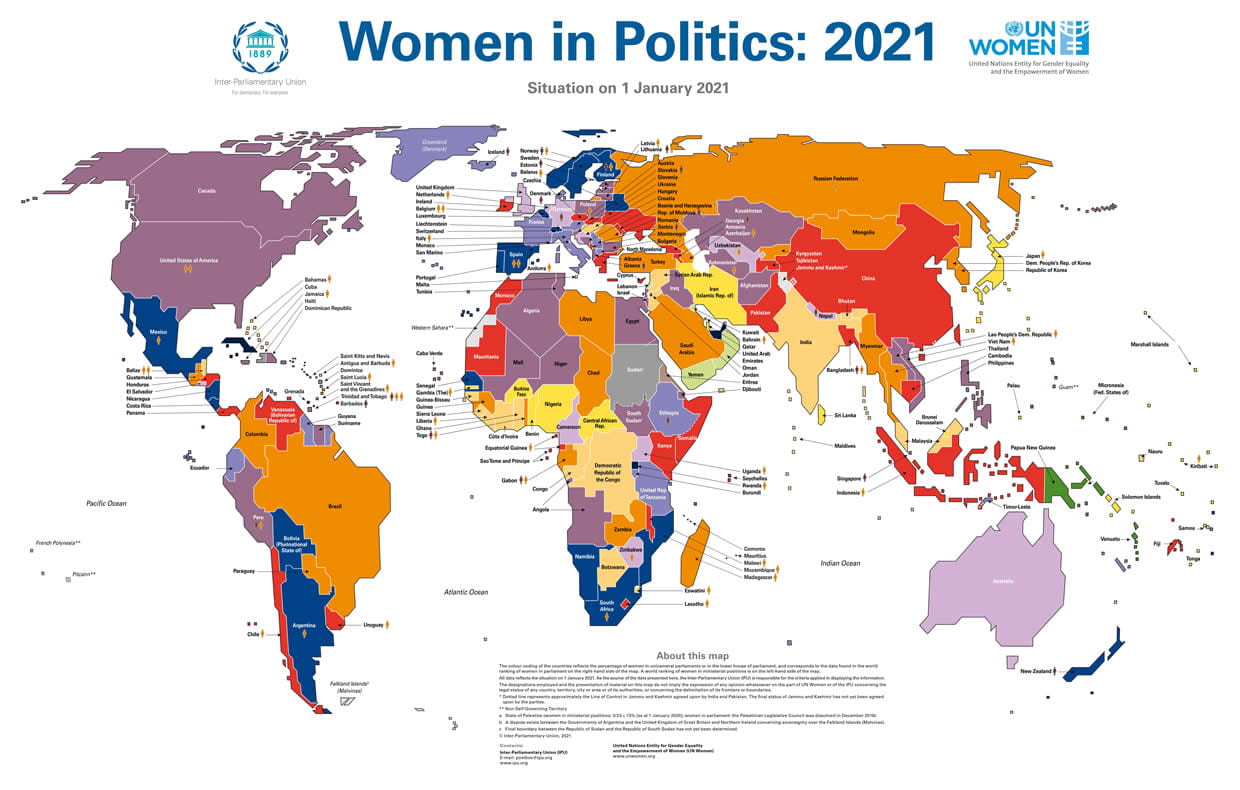
“Women are Turning Green”
Women in Political Power and State Environmentalism:
The authors Kari Norgaard and Richard York wrote about how to improve “Gender Equality and State Environmentalism,” the two authors place a key emphasis on how improving gender may lead to further ecological reforms. (Norgaard, York PDF 14) An interesting quote in their research claims that “women are more likely than men to express support for environmental protection and that women consider a variety of environmental risks, from nuclear power to toxic substances, to be more serious than do men.” (Norgaard, York). Increasing and respecting women’s gender equality would then lead to improved environmental conditions throughout the world. “societies with higher levels of gender equality are more supportive of environmental protection.” (Norgaard, York). An important way to orchestrate this change would be to ensure that women are fairly included in any legal policy involving environmental issues which could result in mitigating climate change. What Norgaard and York have found is basically that countries that treat women better are generally more likely to treat the environment better. There seems to be a stereotypic gender bias arising which confirms the philosophy that men care about money and women care about the earth. Categorizing gender roles with such strict adherence to social stereotypes devalues all genders.
Norgaard and York also found a link between “foreign direct investment” and a lack of state environmentalism. They determined that smaller countries are less likely to care about the environment if they are being given money from different countries throughout the world. An interpretation can be logically drawn that the more economically advanced countries in the world such as the US, Great Britain etc. may be apathetic to the environmental consciousness of other countries maintaining a self-centered and hollow commitment to the world’s shared environmental crisis. The implication here is that countries like The United States, Russia, and the United Kingdom which give a lot of foreign aid to smaller countries do not want these countries to be greener. This leads into Norgaard and Yorks arguments that capitalism is a root cause of the environmental issues Earth is currently experiencing.
There is a positive, direct correlation between the degree of political power that a society shows women and the rate of environmental support. Research and experiences increasingly show the transformative power of inclusive decision making and both women’s and men’s unique differentiated knowledge in successful environmental programming and sustainable development. For example, at the national and international level, countries with more women parliamentarians are more likely to ratify environment treaties. At the community level, in India and Nepal, forest management groups that included women showed better resource governance and conservation outcomes.

According to the new data, women occupy the role of Heads of State or Government in 22 countries, up from 20 countries in 2020. As of 1 January 2021, 5.9 per cent of elected Heads of State (9 out of 152) and 6.7 per cent of Heads of Government (13 out of 193) are women. Europe is the region with the most countries led by women: five out of nine Heads of State and seven out of 13 Heads of Government. The Nordic countries of Denmark, Finland, Iceland, and Norway are all currently led by women.
Environment is the top portfolio held by women. The environment or energy portfolio jumped from third place in 2020 to the top spot in 2021 of ministerial portfolios held by women. Women ministers nonetheless continue to dominate portfolios covering social affairs, women’s affairs, and gender equality. However, women’s share in traditionally male-led ministerial portfolios has slightly increased in 2021 compared to 2020; for example, there are now 13.5 per cent of defense portfolios held by women compared to 11.9 per cent a year ago, and 11.5 of finance portfolios compared to 10.1 per cent a year ago. https://www.unwomen.org/en/news/stories/2021/3/press-release-women-in-politics-new-data-shows-growth-but-also-setbacks
Christiana Figueres Diplomacy

After heading a climate-change nonprofit for eight years, Christiana Figueres took on leadership of the UNFCCC, the body responsible for international climate-change negotiations, at the agency’s lowest point. Just five months earlier, the world failed to reach an agreement at the 2009 Copenhagen summit. She injected a unique sense of optimism, attempting to remove the talks from what she calls “the political trash can.” It worked: Figueres successfully steered world leaders to reach the Paris Agreement in 2015. Along with a number of other women involved in the negotiations, Figueres was successful in shedding an important light on the gender dimension of climate change.
The CBD (Center for Biological Diversity) recognized from the outset the crucial link between women and biodiversity conservation. Preambular paragraph 13 of the CBD states: Recognizing also the vital role that women play in the conservation and sustainable use of biological diversity and affirming the need for the full participation of women at all levels of policy-making and implementation for biological diversity conservation. The phrasing of this paragraph is in line with the prevailing recognition of (and thinking on) the importance of women in environment and development issues at that time (IUCN, 1994). The paragraph clearly shows recognition by the State Parties to the CBD that gender issues, particularly those related to women, should be taken into account. However, the wording of that recognition denotes a rather instrumental understanding of the role of women in biodiversity conservation and sustainable use (Brand, Görg, Hirsch, & Wissen, 2008, p. 75).
Nicky Broeckhoven. “Biodiversity Loss and Climate Change: Gender Issues in International Law and Policy.” DiGeSt. Journal of Diversity and Gender Studies, vol. 1, no. 2, 2014, pp. 23–38. JSTOR, https://doi.org/10.11116/jdivegendstud.1.2.0023. Accessed 15 Mar. 2023
In the world today, there are social stratifications which are gender oriented. Some of these have a direct effect on women and the environment in a degrading way. This concern extends beyond country borders. It is a global concern. Women and nature have had an understandably symbiotic relationship. There is a common thread that runs through both which results in a deeper sense of compassion and responsibility for “Mother Earth”. Current world environmental issues can be partially attributed to this break in the chain between women and the environment. Norgaard and York theorize that societies that have higher, more developed levels of supportive environmental protection, also have higher levels of gender equality.

This image sourced from C. Gardner on WGS-PHL 307 Blackboard
This image represents the interconnectivity between all women and their respective relationship to the international responsibility of focusing on solutions to Climate Change. Women in influential, high-profile positions, especially in governmental jobs have a responsibility to raise the conciseness of their constituency in contributing to the solution.

Your ability to address current issues and relevant topics is impressive. Your blog has been a source of timely information during challenging times. Commercial Wallpaper
server motherboards are essential components of systems used in both residential and commercial settings. As such, it’s important to recognize the role of both female and male representatives in securing the best hardware to serve the needs of users. With more women in influential positions within government organizations, there can be significant environmental gains due to increased efficiency and reduced resource consumption. #womenempowerment #genderdiversity #ecofriendly
Hi Catherine – great work! I especially appreciate the Women in Politics map that you chose; I also came across it and found it interesting and informative. The map illustrates that the Nordic countries are led by women, and this was one of the key pieces of support in Norgaard and York’s study. Norway was referenced as an example of a country that demonstrates a direct connection between the number of women in parliament and the importance placed on environmental issues. Norgaard and York state “Norway retains a highly developed welfare state and a generally high quality of life for all citizens (e.g., good access to health care, high human rights, low poverty un unemployment rates)” (York, 2005, 516). In my current workplace, we are aiming for people to be involved in the planning of the decisions that directly affect them. We see this idea carry over to government bodies and the impact it has when women are involved in making decisions around issues that have a direct correlation to them (reproductive rights, environmental initiatives, healthcare, etc.). I also find it interesting that with women largely represented in the Norwegian government, they have also addressed the issue of gender equality. I’m not sure if this was intentional, or a by-product of their enacted policies, but this has extended to parental leave. Norway stands out as having a very generous and liberal policy with both paid and unpaid time off for parents, up to a full paid year off (Iversen, 2022). With policies like this in place, it shows a strategic importance placed on parenthood and family bonding. Here’s to more women being encouraged to play an active role in government bodies across the globe so that we can continue to place emphasis on care for each other and the world around us.
Iversen, N. (2022, October 21). Parental Leave In Norway Explained (2022 Figures & Numbers) – The Norway Guide. The Norway Guide. https://thenorwayguide.com/parental-leave-in-norway/
Kari, & York, R. (2005). Gender Equality and State Environmentalism. https://pages.uoregon.edu/norgaard/pdf/Gender-Equality-Norgaard-York-2005.pdf
Catherine –
Your blog was terrific! You summarize Norgaard and York’s work very well and in a way that those not familiar with this topic would be able to understand.
I don’t know about you, but it doesn’t surprise me at all that there is a connection in terms of those countries whose numbers support more gender equality, having better performance overall when it comes to environmental advocacy being more at the forefront. It did disturb me however to learn that even in countries when women are represented more equally at the table, that they are typically not afforded the same amount of time (or time at all) to speak amongst their male colleagues. While they may have higher that exhibit more participation of women in politics, it is evident that they are still not afforded the time that men are (Jaffe and Nathanson,7).
You wrote that “There seems to be a stereotype gender bias arising which confirms the philosophy that men care about money and women care about the earth. Categorizing gender roles with strict adherence to social stereotypes which devalues all genders.” I think this is a very astute observation. We often focus on the marginalized group (women) and evaluate how they are impacted adversely but we don’t often think about the disservice that the gender role has on men. How might these gender roles be adversely affecting men and their ability to lead more effectively and be of service to more people?
You mentioned that Europe is the region with the most countries led by women. I thought that you would find this interesting. I saw Finland mentioned frequently as an example of a country lead by a female prime minister. Sanna Marin is demonstrating that she has an agenda focused on social equality, welfare, and climate change. “Finland was rated the happiest country 6 years in a row according to The World Happiness Report” (Heimuli, 2023). Interestingly, of the top ten happiest countries, five of the ten are run by women. According to the University of Wurzburg, when they ranked the quality of democracy of 176 countries, the top three countries (Denmark, Norway, and Finland) are all run by women. The study evaluated freedom, quality, and control (Helliwell, 2022). I have included the link to the democracy matrix below. The evaluation is interesting.
Citations:
Bauer, Pat. “Sanna Marin”. Encyclopedia Britannica, 12 Nov. 2022,
CGEP, Columbia |. “Women and Gender in Climate Diplomacy – Center on Global Energy Policy at Columbia University: Sipa.” Center on Global Energy Policy at Columbia University | SIPA, 3 Feb. 2023, https://www.energypolicy.columbia.edu/publications/women-and-gender-climate-diplomacy/.
Heimuli, Britney. “Finland Ranked the Happiest Country for 6th Year.” Deseret News, Deseret News, 20 Mar. 2023, https://www.deseret.com/u-s-world/2023/3/20/23648431/finland-ranked-happiest-country-in-the-world-by-un-group.
Helliwell, John F., et al. “World Happiness Report 2022.” The World Happiness Report, 18 Mar. 2022, https://worldhappiness.report/ed/2022/.
“Brief Presentation.” Julius-Maximilians-Universität Würzburg, https://www.democracymatrix.com/brief-presentation.
“Ranking of Countries by Quality of Democracy.” Julius-Maximilians-Universität Würzburg, https://www.democracymatrix.com/ranking.
Jennifer,
Thank you for your in-depth, perceptive and accurate assessment of my post, you have added additional dimension and understanding with your post. I agree with your point in regard to feeling a need for additional clarification of why Norgaar and York used participation in environmental treaties as the sole indicator of state environmentalism. I had not made that connection before.
Best,
Catherine
Hi Catherine,
Thank you for your post on this topic! I found the way you connected this week’s readings with political developments in 2015 Paris Agreement very helpful. I had been unaware of Figueres’ role in reaching an agreement on this topic fighting climate change.
I also appreciated that you brought up Norgaard and York’s writings on the connection between foreign direct investment and a state’s commitment to environmental protection. According to Norgaard and York’s study, a higher dependence on foreign investment is associated with a lower likelihood of a state ratifying international environmental treaties. However, as you pointed out, wealthier countries who make such investments are significantly benefiting from the lower standards of protection for environmental and human rights in countries less economically well-off. This is one of the reasons many US companies do their manufacturing in other countries.
Nevertheless, only the ratification of an international treaty was counted as a measurement of a state’s level of commitment to environmental protection in Norgaard and York’s study. Thus, the role of wealthy countries in the exploitation of less wealthy countries was not taken into account. Norgaard and York admit this in their study when they stated, “it is clear that one should not assume that states that demonstrate environmental concern by participation in environmental treaties are necessarily environmentally responsible” (2005, p. 513). Despite this, Norgaard and York used the number of treaties signed as their sole indicator of state environmentalism, with the only justification that it is “a widely accepted approach” (2005, p. 510). For such an important part of their data analysis, I would have appreciated a clearer explanation of why they chose this method in spite of the shortcomings they describe later in the paper.
In general, I found Norgaard and York’s use of ecofeminist theory convincing, and there seems to be several other studies with similar conclusions that gender equality and environmental protection are linked. However, I did not see how Norgaard and York’s actual study and results matched or significantly proved their hypothesis. I do not have a background in science, so my analysis of this study may be faulty. I would be interested if other people have different interpretations of Norgaard and York’s methodology.